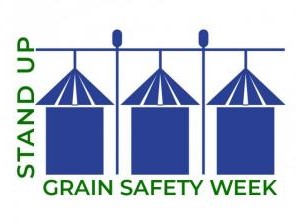By Lisa Pfeifer

Every year hundreds of employees are injured or die from preventable hazards while working in grain storage and handling. Stand Up 4 Grain Safety is an awareness campaign running this week to promote the safety of workers from hazards found in areas of grain handling facilities and on-site storage including grain bins and their surrounding area. The National Stand Up 4 Grain Safety Week is sponsored by an alliance of agricultural industry groups, to provide a collective industry focus and commitment to safety. Everyone deserves to go home from work each day, to that end the industry alliance and safety professionals together recognize a stand for safety March 29 – April 2, 2021. Five learning sessions are offered throughout the week to highlight different aspects of grain handling, from the impact of grain quality on safety to planning and reporting. In addition to the daily live learning sessions, https://standup4grainsafety.org houses multiple resources for use within places of employment.
Workers of all ages are at an increased risk when poor grain quality causes reduced flow, bin safety practices are not followed, and emergency action plans are not in place. Practicing simple steps and ensuring protocols are in place will save lives.
Some of the biggest safety concerns present are located at the bin. Slip, trip, and fall hazards are prevalent. Engulfment can happen in seconds. Combustible or toxic environments can be hidden to the naked eye. Entanglement and amputations can happen at the storage facility even after harvest season has been completed.
Follow these safety tips when working in and around grain storage:
- Frequently check ladders and stairways attached to the bin for needed repairs.
- Make sure guards are in place on all equipment.
- Turn off and lock out all equipment.
- Ensure no grain is being moved into or out of the bin.
- Test the air within a bin prior to entering.
- Use a N-95 mask when working in a bin with grain.
- Wear a body harness with a lifeline when entering a bin.
- Utilize a farm employee or family member to act as an observer outside the bin when entering.
- Do not walk down grain to make it flow.
- Never enter a bin if there is the potential for bridged grain.
- Account for any items you take into a bin and ensure return to the outside of the bin, so equipment does not later become clogged.
In Ohio there are several services and tools to support industry facilities or farms concerned with safety issues:
Ohio BWC Safety Services has safety and health professionals throughout the state to help every Ohio employer in every industry reduce the risk of employee injury and illness, offering services at no cost to employers. BWC's specialists can provide consultative services in the areas of industrial safety, construction safety, ergonomics, and industrial hygiene. Request any consultation service online or by phone at 800-644-6292.
Ohio OSHA On-site Consultation can be requested by employers for support in finding and correcting safety hazards in the workplace. Services range from free on-site and virtual safety inspections and consultation, safety program assistance, and safety and hygiene training or seminars, to printed and electronic resources. Unlike the federal OSHA program, OSHA On-Site does not have right of entry to a workplace and does not issue citations or fines. An employer must make the consultation request, and mutually agree upon a time frame within which to correct any safety hazards identified. Call 800-282-1425 or submit the request online.
Ohio BWC Library provides free informational resources on occupational safety and health, workers' compensation, and rehabilitation. Experienced librarians will locate hard-to-find information and provide timely and accurate answers to your questions. If you have a research question about occupational safety & health, call 614-466-7388 or email library@bwc.state.oh.us, and one of the librarians will help you. For questions about their collection of safety training videos and video streaming service, call 614-644-0018.
OSU Agricultural Safety and Health Program directs, coordinates, and administers educational programs, demonstrations and resources to support agriculture and the safety of those working in the industry. As part of Ohio State University Extension’s outreach in this area a comprehensive agricultural rescue program is offered to address safety around grain handling. The program consists of Ohio Fire Academy curriculum and professional training for first responders, as well as OSU Ag Safety Grain Handling Awareness curriculum for outreach education and awareness for farmers and the agricultural community. Please visit agsafety.osu.edu to learn more.
Wayne County Regional Training Facility -- Safe Farms Facility is a new training resource available for agricultural safety training as well as rescue training for grain entrapment. It is part of a training campus that has been conducting a diversified list of courses covering Fire, EMS, Agriculture, and other specialty classes/courses over the last 30 years. For a full list of courses and resources offered by the WCRTF, please visit wcfra.com.
Source : osu.edu